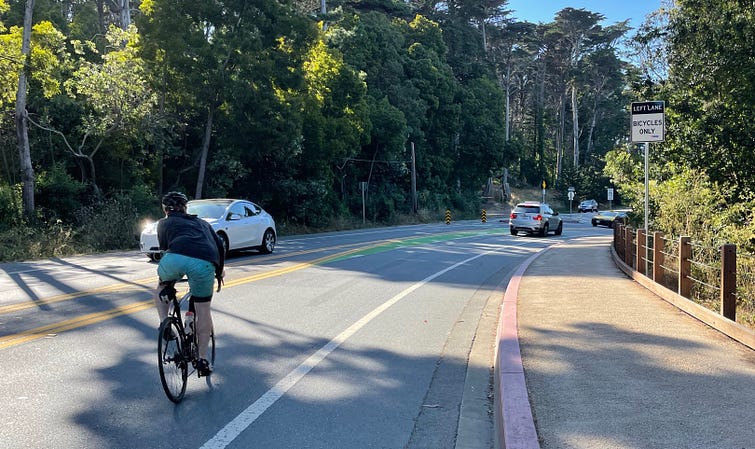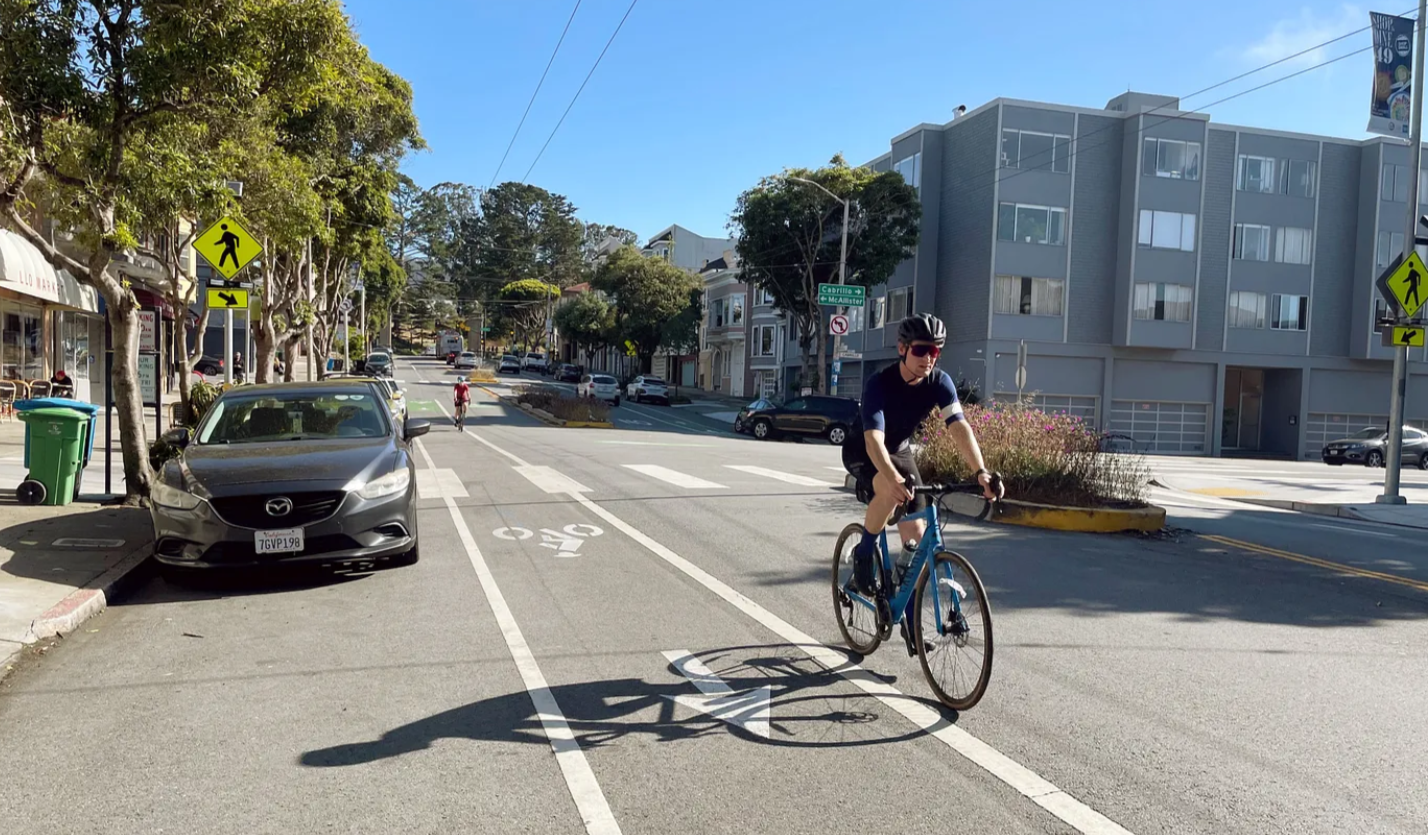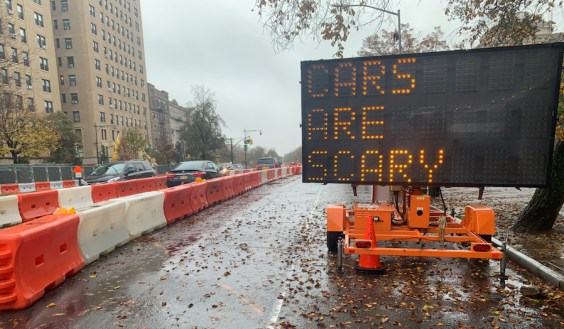A version of this article first appeared in The Frisc and is reprinted with permission.
When champion cyclist Ethan Boyes was killed by a driver in the Presidio in April, street-safety advocates, the San Francisco Municipal Transportation Agency, and city supervisors all expressed a sense of urgency to make bicycling along Arguello Boulevard safer.
In May, supervisors Connie Chan and Catherine Stefani even directed extra money — $100,000 from Community Response Team funding — to bolster SFMTA’s regular budget and speed up plans for protected lanes. An SFMTA spokesperson told the SF Chronicle in May that the agency was sharing an early draft design “given the urgency of the situation.”
Four months later, the need to move fast has produced few results, even while the city’s planners work on an upgrade to make streets across the city safer for anyone not in a car. Meanwhile, new data have emerged that underscore how Arguello is a vital biking corridor for weekday riders and weekend tourists and athletes alike.
Sup. Stefani, whose District 2 includes part of Arguello, wants things to happen faster. “Despite project complexities identified by SFMTA engineers, the need for immediate implementation is evident,” she told The Frisc via email.
So far, the city has done nothing along the one-mile stretch of Arguello under its jurisdiction from Fulton Street to the Presidio gate.
In the Presidio itself, where Arguello winds down to the main parade ground, the Presidio Trust announced it would install new signs and pavement markings at the hazardous intersection of Arguello and Washington Boulevard near where Boyes — who won 10 U.S. track cycling titles — was killed, and add flexible posts to separate bike lanes from the roadway until more permanent infrastructure (bollards) are installed in 2024.
Four months later, only new signs and paint markings have been installed. Nothing else about Arguello has changed. Check that: The memorial ghost bike placed at the site where Boyes was killed is gone.
[Update, 8/11/23: In the Presidio, upgraded signs, pavement “sharrow” markings, and plastic bollards will be installed in the early fall, according to a Presidio Trust representative. Once this work is completed, the Trust plans to install rumble strips and speed cushions by the end of 2023.]

This lack of progress prompted advocacy group Slow Lake Street to post data last month highlighting the prevalence of bicyclists along Arguello. A sensor in either a private home or business between Clement and Euclid streets tallied 20,000 bike trips over three weeks, which accounted for 17.3 percent of all street users, including pedestrians, cars, and trucks, during that time.
The data comes from a sensor developed by the Belgian company Telraam, which is working with local advocates on a project to place 50 of these devices on SF slow streets and other thoroughfares. This project has inspired others to deploy their own sensors, as is the case with the one on Arguello.
Slow Lake Street’s post was meant to keep up the pressure on for better bike infrastructure: “Hurry up with that protected lane design, @sfmta_muni and @presidiosf.”
But SFMTA, which has jurisdiction over Arguello from Fulton Street to the Presidio gate, is moving at its own pace. SFMTA’s livable streets manager Matt Laskey cited complexity of design and staffing shortages as bottlenecks, and said final changes won’t likely be in place until next spring at the earliest.
Quick builds should be … quick
The aftermath of Boyes’s death wasn’t the first time SF officials had called for protected bike lanes on Arguello. Last December, the city’s Bicycle Advisory Committee passed a resolution in support of this safety measure — nearly one month after a 16-year-old bicyclist was critically injured when a car struck him on Arguello at California Street. But it’s the Boyes tragedy and the following outcry that elicited a pledge from SFMTA to take action.
There is an official website for the Arguello Safety Project, and it displays a timeline indicating the agency should be designing the project and doing community outreach now. (Laskey confirmed that outreach won’t start until September.)

Safe-street advocate Luke Bornheimer, who runs the Protected Arguello campaign, says the outreach is unnecessary. “There’s nothing to be gleaned,” said Bornheimer, adding that only confusion, delay, and watered-down safety measures could come from the process.
SFMTA says Arguello requires outreach because it is lined with single-family homes, apartment buildings, and driveways. It includes two small commercial corridors, one near Golden Gate Park, the other between Geary Boulevard and California Street, along with a middle school, three houses of worship, and the Indian consulate. “There are a lot of challenges, including cross streets that are important to transit like Geary,” says SFTMA’s Laskey.
Laskey adds that the agency could lean heavily on the Quick Build program to remake Arguello, which means changes shouldn’t require lengthy construction or drawn-out processes. Yet at the current pace, it’s possible that nearly a year will have passed between Boyes’s death and the completion of the Arguello makeover. (Walk SF director Jodie Medeiros criticized SFMTA earlier this year for not using quick build to its fullest extent.)
In the meantime, the northern half of Arguello, from Geary to Pacific Street and the Presidio gate, remains part of the High Injury Network — the 12 percent of SF streets that see 68 percent of the crashes.
Nowhere near Vision Zero
SF officials set a Vision Zero goal in 2014 to eliminate traffic deaths by 2024, which isn’t going to happen. There have been 11 fatalities so far this year, and 2022 saw the most deaths since the Vision Zero pledge was set.
Street-safety advocates’ frustration with that trend prompted private residents to take action earlier this year. Yelp CEO Jeremy Stoppelman has financed a network of the Telraam sensors to provide street-level data that SFMTA long has failed to provide.
The Telraam counter on Arguello isn’t part of the Stoppleman-backed network, but the sensor’s owner is sharing the data publicly. The Frisc checked with Telraam, which is headquartered in Belgium, to ask about the results. There’s at least one caveat to the 20,000 riders over three weeks: The device only “counts traffic when there’s sufficient daylight,” said Telraam co-founder Kris Vanherle, so it’s better to use average hourly numbers. “It’s more telling and comparable.”
Turns out SFMTA has a traffic counter on Arguello as well. The agency has embedded pneumatic tubes in the asphalt, but they come with a technical caveat, says Laskey: They transmit their data via 1G or 2G cellular technology, much older than current wireless networks. It’s unclear if this accounts for the notable discrepancy between the public and private tallies.
From 2018 to 2023, SFMTA’s counter tallied an average of six weekday riders per hour; the Telraam sensor (covering a much shorter time period) has counted 50.
On weekends, the SFMTA device counted an average of 50 riders per hour; Telraam counted 96.
One last caveat: The two counters are several blocks apart. SFMTA placed its device near Golden Gate Park, while the Telraam sensor is a half-mile away, on the busy block between Clement and Euclid.

Technology and locations aside, the ridership trends from both systems are the same. Arguello gets heavier bike traffic on weekends than on weekdays, as the street is a major conduit for bicyclists — including elite ones like Ethan Boyes — to ride from the city into the Presidio, and onwards from there to the Golden Gate Bridge and Marin Headlands.
The city’s current bike network was crafted more than a decade ago, but it hasn’t delivered safer streets. All the while, climate change is intensifying, adding urgency to shift more people out of cars toward active transport — bikes, scooters, and other people-powered devices.
SFMTA’s new citywide plan should be ready early next year. The agency is in the midst of a year-long outreach process, especially in neighborhoods that feel left behind by the biking wave. The outreach has already produced a survey with this important point: 80 percent of participants would like to use active transport to get around, but only 23 percent feel comfortable enough to ride on city streets.
What’s more, the survey showed that people want more separation from cars to feel safe riding bikes and scooters. That should translate into a protected bike lane for Arguello, and the sooner the better.






